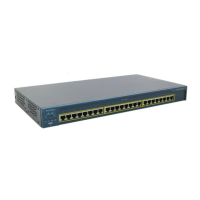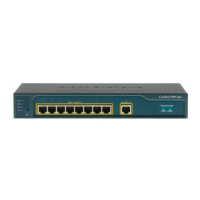13-10
Catalyst 2950 and Catalyst 2955 Switch Software Configuration Guide
78-11380-12
Chapter 13 Configuring STP
Understanding Spanning-Tree Features
Spanning-Tree Interoperability and Backward Compatibility
Table 13-2 lists the interoperability and compatibility among the supported spanning-tree modes in a
network.
In a mixed MSTP and PVST+ network, the common spanning-tree (CST) root must be inside the MST
backbone, and a PVST+ switch cannot connect to multiple MST regions.
When a network contains switches running rapid PVST+ and switches running PVST+, we recommend
that the rapid-PVST+ switches and PVST+ switches be configured for different spanning-tree instances.
In the rapid-PVST+ spanning-tree instances, the root switch must be a rapid-PVST+ switch. In the
PVST+ instances, the root switch must be a PVST+ switch. The PVST+ switches should be at the edge
of the network.
STP and IEEE 802.1Q Trunks
The IEEE 802.1Q standard for VLAN trunks imposes some limitations on the spanning-tree strategy for
a network. The standard requires only one spanning-tree instance for all VLANs allowed on the trunks.
However, in a network of Cisco switches connected through IEEE 802.1Q trunks, the switches maintain
one spanning-tree instance for each VLAN allowed on the trunks.
When you connect a Cisco switch to a non-Cisco device through an IEEE 802.1Q trunk, the Cisco switch
uses PVST+ to provide spanning-tree interoperability. If rapid PVST+ is enabled, the switch uses it
instead of PVST+. The switch combines the spanning-tree instance of the IEEE 802.1Q VLAN of the
trunk with the spanning-tree instance of the non-Cisco IEEE 802.1Q switch.
However, all PVST+ or rapid-PVST+ information is maintained by Cisco switches separated by a cloud
of non-Cisco IEEE 802.1Q switches. The non-Cisco IEEE 802.1Q cloud separating the Cisco switches
is treated as a single trunk link between the switches.
The external spanning-tree behavior on access ports and trunk ports is not affected by PVST+ or rapid
PVST+.
For more information on IEEE 802.1Q trunks, see Chapter 16, “Configuring VLANs.”
Table 13-2 PVST+, MSTP, and Rapid-PVST+ Interoperability
PVST+ MSTP Rapid PVST+
PVST+ Yes Yes (with restrictions) Yes (reverts to PVST+)
MSTP Yes (with restrictions) Yes Yes (reverts to PVST+)
Rapid PVST+ Yes (reverts to PVST+) Yes (reverts to PVST+) Yes

